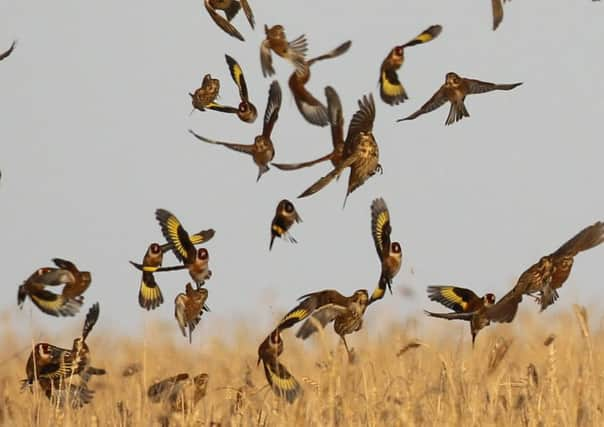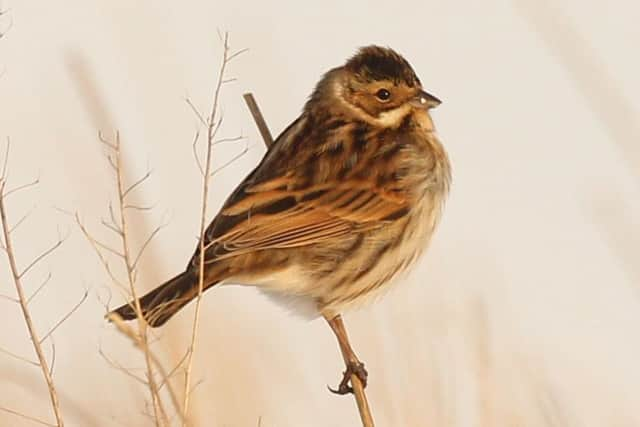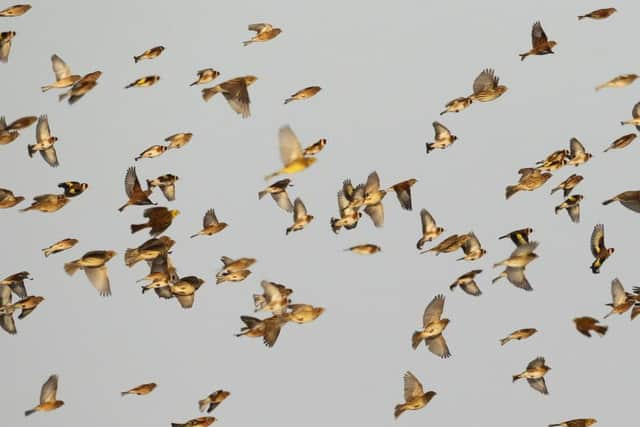Robert Fuller: Bounty for birds from wildlife friendly farming


From my studio window, I have a commanding view over four miles of one of the most beautiful parts of the Yorkshire Wolds. This landscape is where I get a lot of my inspiration from for my paintings. It is also where most of my wildlife encounters take place.
Last May, they drilled a 40 metre wide strip of wild bird cover mix in the land adjacent to my garden. They left the rest of the field as stubble as part of their commitment to the Higher Level Stewardship Scheme. This strip has attracted thousands of birds and animals in the last eight months.
Advertisement
Hide AdAdvertisement
Hide AdSuch strips are designed to help birds through the long winter months by providing seed for small species like finches and bunting. But this particular strip was bringing in wildlife from the moment it was first drilled.


I was brought up on a farm in the Yorkshire Wolds hamlet of Great Givendale, where my father, Richard Fuller, was farm manager for 32 years.
Although commercially minded, my dad has a great interest in conservation. Forty years ago, he was digging ponds whilst others drained them and planting hedgerows whilst others ripped them out. Thankfully, thinking has changed with farming and conservation now coming together.
Even though I’ve not done any farm work since I was a teenager, I still have a deep, lasting interest in farming and I watch the landscape around me undergo changes through the seasons with more than just passing sentiment. So I was particularly interested in watching how things developed on this strip. Straight after sowing stock, doves, partridges, even tree sparrows flocked en masse to the bare soil trying to peck any seed which was not drilled deep enough.
Advertisement
Hide AdAdvertisement
Hide AdAs the crop started to emerge from the stony soil, hares and wood pigeons appeared and nibbled on the first green shoots.


The crop shot up and was soon 3ft high and flowering. I made a point of walking along the field edge to see what was happening. I could clearly recognise some species, like sunflowers, which weren’t faring so well, but I didn’t recognise some of the others, one of which turned out to be fodder radish. As I walked along I was struck by the sound of buzzing – the crop was alive with a multitude of insects.
By autumn, the white flowering heads of fodder radish had turned into seed pods. I popped one of the pods, which even though it was still green, was full of seeds.
I walked down the hedge alongside the crop and admired the millions of pods, all brimming with seeds. I was expecting a bird bonanza later in the year. And, it was going to happen right on my doorstep.
Advertisement
Hide AdAdvertisement
Hide AdI heard a sharp ‘cheep’ bird call ahead of me - the sound of a yellow hammer - and I looked up to see a handful of these bright yellow birds flying out of the crop and into the hedge.


I walked up to where they had just flown from and found seed cases that had been carefully picked open. The seeds were gone. I opened a seed pod out of interest and couldn’t resist trying one of the seeds for myself – they were delicious – no wonder these birds were coming.
As these seed pods dried over autumn, the variety of bird species increased. Linnets, goldfinches and tree sparrows all flocked in huge numbers to the strip. Next came winter visitors from Scandinavia: bramblings. Bramblings are beautiful birds, but because they are not resident to this country most people don’t get a chance to see one up close.
They have intricate feather markings which give them a striking look, an orange buff breast with white under parts and white rump which can be seen when they fly, a delicately flecked grey and black head and exquisite grey-brown markings along their flanks.
Advertisement
Hide AdAdvertisement
Hide AdThe flocks were always a mix of different species in flight. By November there were more than 2,000 small birds feeding on the bounty, swirling overhead in the sky before zooming down in formation onto the seeds.


I saw half a dozen reed buntings visit the crop. I don’t normally expect to see them around here. They favour areas with water in summer, but this bounty had brought them in. They are a shy bird and so didn’t flock together with the others. They preferred to perch on my hedge, fly into the crop to forage for seeds and then return to the hedge.
I was hoping an over-wintering merlin might find the flock, but instead my local sparrowhawks were kept busy, especially one male. I found his plucking post in a quiet corner of our garden and was able to see what he was catching each day. I collected the feathers of linnets, bramblings, goldfinches and tree sparrows.
I put up a hide on stilts on the edge of my garden and enjoyed photographing 2,000 noisy birds swirling around me before landing in to feed. I was hoping a sparrowhawk would fly in but instead a kestrel hovered above. The kestrel wasn’t a threat to these birds but the birds were nervous and they all flew up at once and formed a tightly-packed flock to confuse this bird of prey.
Advertisement
Hide AdAdvertisement
Hide AdI felt so privileged to have so many birds here on my home turf. What a treat it has been.
BIRD IDENTIFICATION EXHIBITION
Brush up on your bird identification skills at Robert Fuller’s gallery in Thixendale for the RSPB’s Big Garden Birdwatch - the largest citizen nature observation in the world.
The artist hopes to encourage people to take part in this year’s annual bird census with a free bird identification event which runs from January 27-29 and features videos and displays showing information boards on different bird species.
There will also be a bird watching safari into the Yorkshire Wolds at 10.30am on January 27 and 29. An ornithologist will be on hand to point out the different species.
The bird watching safari costs £9.50 per person. To book a place visit www.robertefuller.com